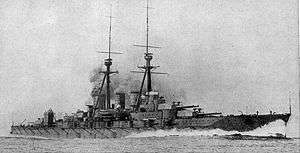Siemens scandal

The Siemens Scandal (シーメンス事件 Shīmensu jiken) of January 1914 was one of several spectacular political scandals of late Meiji and Taishō period Japanese politics, leading to the fall of the cabinet of Yamamoto Gonnohyoe. It involved collusion between several high-ranking members of the Imperial Japanese Navy, the British company Vickers and the German industrial conglomerate of Siemens AG.
Description
The Japanese navy was engaged in a massive expansion program, and at the time, many major items (such as advanced warships and weaponry) were still being imported from Europe. Siemens had secured a virtual monopoly over Japanese naval contracts in return for a secret 15% kickback to the Japanese naval authorities responsible for procurement.
In 1914, the British firm of Vickers (via their Japanese agents Mitsui Bussan) offered the Japanese naval authorities a more lucrative deal, involving a 25% kickback, with 40,000 Yen for Vice Admiral Matsumoto Kazu, the former Chief of the Navy Technical Department, specifically involving the procurement of the battlecruiser Kongō.[1][2] When the German headquarters of Siemens found out about the deal, they sent a telegram to their Tokyo office demanding a clarification. An expatriate employee of the Siemens Tokyo office (Karl Richter) stole incriminating documents indicating that Siemens had previously paid a bribe of 1,000 pounds sterling to the Japanese navy in return for a wireless contract, sold the documents to the Reuters news agency together with a copy of the telegram, and fled back to Germany.
Japanese newspapers, notably the Asahi Shimbun [3] immediately reported the details of the corruption scandal, and the issue was raised in the Diet by members of the Rikken Doshikai political party. Both the Army and Navy Intelligence Services and the Kempeitai launched investigations.
The Japan Weekly Chronicle newspaper reported that an Admiral Fuji of the navy procurement office had confessed to receiving payments from Vickers of a total 210,000 yen in 1911 and 1912 on various occasions, reminding its readers that whether or not the money was received illegally under Japanese law, it was certainly illegal under the British Corrupt Practices Act of 1906.
Reactions
Large-scale demonstrations erupted in Tokyo in early February 1914, which turned violent on 10 February 1914 and 14 February 1914. Public opinion was further outraged when it was revealed the massive scope of the naval expansion program would have left room for little else in the government budget, and that the government was therefore planning to raise taxes.[4] Although Prime Minister Yamamoto was not directly implicated, and he took steps to dismiss naval officers in charge of procurement and shipbuilding, public dissatisfaction continued to grow, and Yamamoto was challenged to explain the bribery allegations before the House of Peers.
After both houses of Diet refused to pass the 1914 Navy budget, Yamamoto resigned on 24 March 1914, bringing down his entire cabinet with him. In May, a military court martial reduced ex-Prime Minister Admiral Yamamoto and Navy Minister Admiral Saito Makoto in rank, sentenced several leading members of the navy procurement department to prison, heavily fined both Vickers and Siemens and banned them from future participation in contracts.
Aftermath
With the start of World War I a couple of weeks later, Vickers was asked to restart production on the Kongō, and the men involved were all pardoned and rehabilitated.
The Daily Telegraph newspaper edition of 21 January 1914[5] reported that Karl Richter had been arrested in Germany for his theft of the incriminating papers, and sentenced to two years in prison.
See also
- 2008 Siemens alleged scandal in Greece, article about payments to Greek political parties and the ongoing investigation.
References
- Bowman, John (2000). Columbia Chronologies of Asian History and Culture. Columbia University Press. ISBN 0-231-11004-9.
- Haley, John Owen (1998). The Spirit of Japanese Law. University of Georgia Press. ISBN 0-8203-2022-6.
- Hoare, J.E. (1999). Britain and Japan: Biographical Portraits, Vol. III. RoutledgeCurzon. ISBN 1-873410-89-1.
- Sims, Richard (2001). Japanese Political History Since the Meiji Renovation 1868-2000. Palgrave Macmillan. ISBN 0-312-23915-7.
Notes
- ↑ Kongō was rebuilt in 1931 and re-designated as a battleship at that time.
- ↑ Hoare, Britain and Japan, page 190
- ↑ Haley, The Spirit of Japanese Law, page 63
- ↑ Sim, Japanese Political History Since the Meiji Renovation 1868-2000, page 115
- ↑ Bowman, Columbia Chronologies of Asian History and Culture, page 150